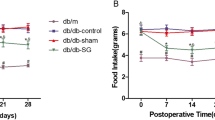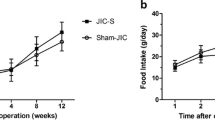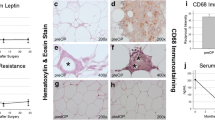Abstract
Background
Current studies indicate that inflammation of white adipose tissue (WAT) is a pathogenic characteristic of insulin resistance. However, the significance of visceral WAT inflammation after bariatric surgery remains unclear.
Methods
Duodenojejunal bypass plus sleeve gastrectomy (DJB-SG) was performed on Goto-Kakisaki rats. Weight, fasting blood glucose (FBG), and homeostatic model assessment of insulin resistance (HOMA-IR) in the DJB-SG group were compared to those in a sham surgery (SHAM) group every 2 weeks. The results of an oral glucose tolerance test (OGTT) and the volume of visceral adipose tissue (Visc.Fat) were compared before and 8 weeks postsurgery. Eight weeks after surgery, the rats were sacrificed and visceral WAT collected from the greater omentum. Tumor necrosis factor-α (TNF-α) and cluster of differentiation 68 (CD68) expression in the WAT were evaluated in paraffin-embedded sections by immunohistochemistry.
Results
Compared with the SHAM group, the DJB-SG group demonstrated a significant reduction in weight, FBG, and HOMA-IR (P < 0.05), with elevation of insulin levels (P < 0.05) from 4 weeks after surgery. OGTT and the quantity of Visc.Fat were significantly reduced (P < 0.05) 8 weeks after surgery. Moreover, the expression of TNF-α and CD68 in the visceral white adipose tissue was significantly lower 8 weeks after surgery (P < 0.05).
Conclusions
The DJB-SG model established in Goto-Kakisaki rats achieved anticipated efficacy. Reduced TNF-α-related inflammation in visceral WAT may result in improved insulin resistance.




Similar content being viewed by others
References
Mokdad AH, Ford ES, Bowman BA, et al. Prevalence of obesity, diabetes, and obesity-related health risk factors, 2001. JAMA. 2003;289:76.
Adams TD, Davidson LE, Litwin SE, et al. Weight and metabolic outcomes 12 years after gastric bypass. N Engl J Med. 2017;377:1143–55.
Sanchez-Pernaute A et al. Proximal duodenal-ileal end-to-side bypass with sleeve gastrectomy: proposed technique. Obes Surg. 2007;17:1614–8.
Kasama K, Tagaya N, Kanehira E, et al. Laparoscopic sleeve gastrectomy with duodenojejunal bypass: technique and preliminary results. Obes Surg. 2009;19:1341–5.
Lee WJ, Lee KT, Kasama K, et al. Laparoscopic single-anastomosis duodenal-jejunal bypass with sleeve gastrectomy (SADJB-SG): short-term result and comparison with gastric bypass. Obes Surg. 2014;24:109–13.
Navarrete SA, Leyba JL, Llopis SN. Laparoscopic sleeve gastrectomy with duodenojejunal bypass for the treatment of type 2 diabetes in non-obese patients: technique and preliminary results. Obes Surg. 2011;21:663–7.
Astiarraga B, Gastaldelli A, Muscelli E, et al. Biliopancreatic diversion in nonobese patients with type 2 diabetes: impact and mechanisms. J Clin Endocrinol Metab. 2013;98:2765–73.
Heneghan HM, Nissen S, Schauer PR. Gastrointestinal surgery for obesity and diabetes: weight loss and control of hyperglycemia. Curr Atheroscler Rep. 2012;14:579–87.
Severino A, Castagneto-Gissey L, Raffaelli M, et al. Early effect of roux-en-Y gastric bypass on insulin sensitivity and signaling. Surg Obes Relat Dis. 2016;12:42–7.
Masoodi M, Kuda O, Rossmeisl M, et al. Lipid signaling in adipose tissue: Connecting inflammation & metabolism. Biochim Biophys Acta. 2015;1851:503–18.
Kanda H, Tateya S, Tamori Y, et al. MCP-1 contributes to macrophage infiltration into adipose tissue, insulin resistance, and hepatic steatosis in obesity. J Clin Invest. 2006;116:1494–505.
Moraes-Vieira PM, Yore MM, Dwyer PM, et al. RBP4 activates antigen-presenting cells, leading to adipose tissue inflammation and systemic insulin resistance. Cell Metab. 2014;19:512–26.
Borst SE. The role of TNF-alpha in insulin resistance. Endocrine. 2004;23:177–82.
Rubino F, Forgione A, Cummings DE, et al. The mechanism of diabetes control after gastrointestinal bypass surgery reveals a role of the proximal small intestine in the pathophysiology of type 2 diabetes. Ann Surg. 2006;244:741–9.
Hill AM, LaForgia J, Coates AM, et al. Estimating abdominal adipose tissue with DXA and anthropometry. Obesity (Silver Spring). 2007;15:504–10.
Rubino F, Marescaux J. Effect of duodenal-jejunal exclusion in a non-obese animal model of type 2 diabetes: a new perspective for an old disease. Ann Surg. 2004;239(1):1–11.
Breen DM, Rasmussen BA, Kokorovic A, et al. Jejunal nutrient sensing is required for duodenal-jejunal bypass surgery to rapidly lower glucose concentrations in uncontrolled diabetes. Nat Med. 2012;18:950–5.
Jurowich CF, Rikkala PR, Thalheimer A, et al. Duodenal-jejunal bypass improves glycemia and decreases SGLT1-mediated glucose absorption in rats with streptozotocin-induced type 2 diabetes. Ann Surg. 2013;258:89–97.
Gavin TP, Sloan RC, Lukosius EZ, et al. Duodenal-jejunal bypass surgery does not increase skeletal muscle insulin signal transduction or glucose disposal in Goto-Kakizaki type 2 diabetic rats. Obes Surg. 2011;21:231–7.
Elffers TW et al. Body fat distribution, in particular visceral fat, is associated with cardiometabolic risk factors in obese women. PLoS One. 2017;e185403:12.
Jablonowska-Lietz B, Wrzosek M, Wlodarczyk M, et al. New indexes of body fat distribution, visceral adiposity index, body adiposity index, waist-to-height ratio, and metabolic disturbances in the obese. Kardiol Pol. 2017;75:1185.
Lee SW, Son JY, Kim JM, et al. Body fat distribution is more predictive of all-cause mortality than overall adiposity. Diabetes Obes Metab. 2018;20:141–7.
Taniguchi A, Nakai Y, Sakai M, et al. Relationship of regional adiposity to insulin resistance and serum triglyceride levels in nonobese Japanese type 2 diabetic patients. METABOLISM. 2002;51:544–8.
Ko GTC, Tang JSF. Waist circumference and BMI cut-off based on 10-year cardiovascular risk: evidence for “central pre-obesity”. OBESITY. 2007;15:2832–9.
Wang J, Thornton JC, Russell M, et al. Asians have lower body mass index (BMI) but higher percent body fat than do whites: comparisons of anthropometric measurements. Am J Clin Nutr. 1994;60:23–8.
Baron SH. Salicylates as hypoglycemic agents. Diabetes Care. 1982;5:64–71.
Allison MA, Jensky NE, Marshall SJ, et al. Sedentary behavior and adiposity-associated inflammation: the Multi-Ethnic Study of Atherosclerosis. Am J Prev Med. 2012;42:8.
Ctoi AF et al. Metabolically healthy versus unhealthy morbidly obese: chronic inflammation, nitro-oxidative stress, and insulin resistance. Nutrients. 2018;10
Hotamisligil GS. Mechanisms of TNF-alpha-induced insulin resistance. Exp Clin Endocrinol Diabetes. 1999;107:119.
Uysal KT, Wiesbrock SM, Marino MW, et al. Protection from obesity-induced insulin resistance in mice lacking TNF-alpha function. Nature. 1997;389:610.
Hotamisligil GS et al. IRS-1-mediated inhibition of insulin receptor tyrosine kinase activity in TNF-alpha- and obesity-induced insulin resistance. Science. 1996;271:665–70.
Plomgaard P, Bouzakri K, Krogh-Madsen R, et al. Tumor necrosis factor-alpha induces skeletal muscle insulin resistance in healthy human subjects via inhibition of Akt substrate 160 phosphorylation. DIABETES. 2005;54:2939–45.
Bouzakri K, Zierath JR. MAP4K4 gene silencing in human skeletal muscle prevents tumor necrosis factor-alpha-induced insulin resistance. J Biol Chem. 2007;282:7783–9.
Li J, Tang Y, Cai D. IKKbeta/NF-kappaB disrupts adult hypothalamic neural stem cells to mediate a neurodegenerative mechanism of dietary obesity and pre-diabetes. Nat Cell Biol. 2012;14:999–1012.
van Greevenbroek MM, Schalkwijk CG, Stehouwer CD. Obesity-associated low-grade inflammation in type 2 diabetes mellitus: causes and consequences. Neth J Med. 2013;71:174.
Leon-Pedroza JI et al. Low-grade systemic inflammation and the development of metabolic diseases: from the molecular evidence to the clinical practice. Cir Cir. 2015;83:543–51.
Kelloff GJ, Sigman CC. Cancer biomarkers: selecting the right drug for the right patient. Nat Rev Drug Discov. 2012;11:201–14.
Sattar N, Gaw A, Scherbakova O, et al. Metabolic syndrome with and without C-reactive protein as a predictor of coronary heart disease and diabetes in the west of Scotland coronary prevention study. Circulation. 2003;108:414–9.
Trak-Smayra V, Dargere D, Noun R, et al. Serum proteomic profiling of obese patients: correlation with liver pathology and evolution after bariatric surgery. Gut. 2009;58:825–32.
Funding
This work was supported by the Science and Technology Planning Project of Guangzhou, China (Nos. 201508020002 and 201604020106), and the Science and Technology Planning Project of Guangdong Province, China (No. 2017ZC0324).
Author information
Authors and Affiliations
Corresponding author
Ethics declarations
Conflict of Interest
Hao Yu, Zhigao Song, Hongbin Zhang, Kehong Zheng, Junfang Zhan,Jingbo Sun, Zhizhi Wang, Lucas Zellmer, Xiaojiang Dai, Wu Liangping declare that they have no conflicts of interest.
Ethical Approval
All procedures performed in studies involving human participants were in accordance with the ethical standards of Guangzhou General Hospital of Guangzhou Military Command’s research committee and with the 1964 Helsinki declaration and its later amendments or comparable ethical standards.
All applicable Guangzhou General Hospital of Guangzhou Military Command’s guidelines for the care and use of animals were followed.
Statement of Animal Rights
All animal experimental procedures involved in this study were approved by the Animal Care and Utilization Committee of Guangzhou General Hospital of Guangzhou Military Command.
Additional information
Publisher’s Note
Springer Nature remains neutral with regard to jurisdictional claims in published maps and institutional affiliations.
Rights and permissions
About this article
Cite this article
Yu, H., Song, Z., Zhang, H. et al. Duodenojejunal Bypass Plus Sleeve Gastrectomy Reduces Infiltration of Macrophages and Secretion of TNF-α in the Visceral White Adipose Tissue of Goto-Kakizaki Rats. OBES SURG 29, 1742–1750 (2019). https://doi.org/10.1007/s11695-019-03755-1
Published:
Issue Date:
DOI: https://doi.org/10.1007/s11695-019-03755-1




